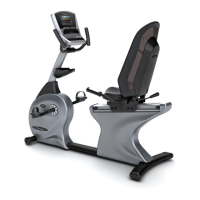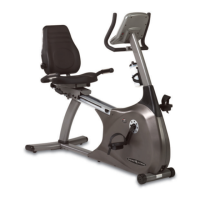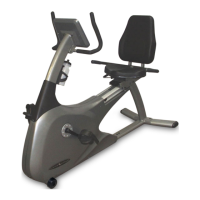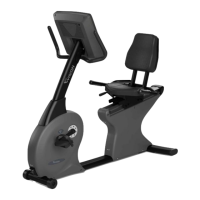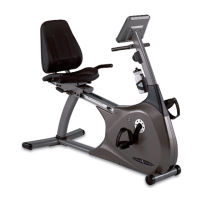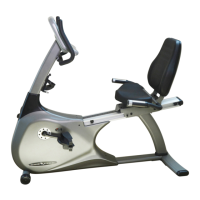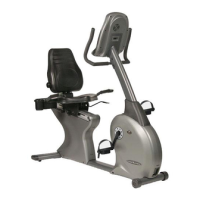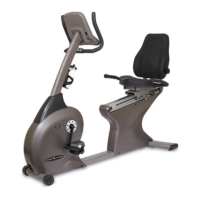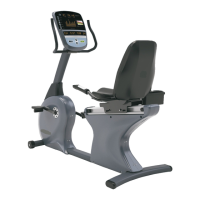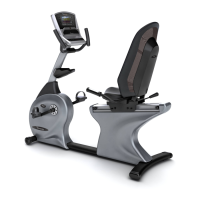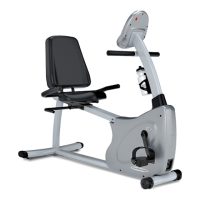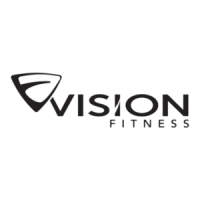
Do you have a question about the Vision Fitness R2650HRT and is the answer not in the manual?
| Resistance Levels | 20 |
|---|---|
| Console Display | LCD |
| Weight Capacity | 300 lbs |
| Dimensions | 64" x 26" x 48" |
| Programs | Manual, Interval, Fat Burn, Random, Fit Test, HR Control, Custom |
| Resistance Type | Magnetic |
| Type | Recumbent |
Safety precautions regarding product use, handling, and maintenance to reduce risks.
Guidelines for keeping children away from the exercise bike during operation and storage.
Precautions for users experiencing discomfort and clothing choice.
Proper methods for cleaning the exercise bike components using mild soap and water.
Guidance on professional assembly or following enclosed instructions for self-assembly.
Instructions on how to safely move the exercise bike using its transport wheels.
How to level the bike for stability using adjustable rear foot supports.
Instructions for adjusting the pedal straps for a secure and comfortable fit.
Steps to raise or lower the seat using the ratcheting seat post mechanism.
Guidance on finding the optimal seat position for effective pedaling and comfort.
How to adjust seat forward/backward using the spring-loaded seat lever.
Using the lumbar control system to adjust lower back support for comfort.
Introduction to the computerized display and its primary functions for tracking workouts.
Functionality of the START button for starting, pausing, and resetting workouts.
Functionality of the ENTER button for scanning displays and holding scan.
How to use the UP/DOWN arrow buttons to adjust values and workout levels.
Using program buttons for quick access to pre-set workouts.
Understanding the dot matrix profile of workout segments and resistance.
Interpreting workout feedback, including time, speed, distance, RPM, etc.
How the console displays heart rate, % Heart Rate, and target heart rate.
Details on CSAFE and Cardio ports for network and entertainment system connections.
Location and purpose of the 9-volt battery for console memory backup.
User-controlled program with adjustable resistance levels.
Workout with alternating work and recovery intervals for cardiovascular training.
Program designed to target stored body fat using lower resistance.
Exercise at a set work level, adjusting resistance based on pedal rate.
Anaerobic interval program for building muscle and improving performance.
High-intensity program to maintain heart rate at 80% for endurance and calorie burn.
Lower intensity program to burn fat reserves at 65% of max heart rate.
Program with alternating 80% and 70% heart rate intervals for fitness.
Program using four target heart rates (65-80%) for strength and endurance.
Quickly begin exercising with the MANUAL program using the START button.
How to choose and navigate through different available workout programs.
Inputting user age for accurate HRT program feedback and calculations.
Setting the desired exercise duration for the selected program.
Inputting user weight for accurate calorie and MET calculations.
Adjusting the resistance level, with up to 20 levels available per program.
Description of the Warm-up, Interval Training, and Cool-down phases of the Sprint 8 program.
Definition and benefits of exercising within target heart rate zones for fitness goals.
How to use the contact hand pulse sensors for accurate heart rate monitoring.
Guidance on correctly positioning the chest strap for accurate and uninterrupted readings.
General operation of HRT programs, including warm-up, cool-down, and monitoring.
How to manually adjust the target heart rate during HRT workouts using console buttons.
Program to maintain 80% max heart rate for cardiovascular endurance and calorie burn.
Program to maintain 65% max heart rate for burning fat reserves.
Program with alternating 80% and 70% heart rate intervals for fitness capacity.
Program using four target heart rates (65-80%) for cardiovascular strength and endurance.
Procedure for entering and navigating through engineering mode options.
List and description of available optional settings controllable in engineering mode.
Tips for regular care and upkeep of the fitness bike to ensure longevity.
Recommended schedule for cleaning and inspecting various bike components.
Troubleshooting steps when the console display does not power on.
Diagnosing and fixing clicking noises from the bike's pedals or components.
Resolving squeaking or creaking noises by checking and tightening hardware.
Fixing the issue of the seat rocking from side to side on semi-recumbent bikes.
Instructions on how to contact retailers for service and required information like serial number.
Troubleshooting steps when no pulse reading appears on the console.
Diagnosing and fixing inconsistent or erratic heart rate readings.
Specific warranty periods for Frame, Motor, Electronics, Parts, and Labor for home use.
Details on warranty coverage, exclusions, limitations, and disclaimers.
Steps for registering the product warranty and providing customer feedback.
Examples of facilities covered under the commercial warranty terms.
Details on warranty periods for Frame, Motor, Electronics, Parts, and Labor for commercial use.
Warranty coverage, exclusions, and disclaimers specific to commercial usage.
Process for commercial facility warranty registration and customer survey completion.
Steps to define personal fitness goals and track progress effectively for motivation.
Importance of writing down goals and creating an exercise schedule to monitor advancement.
Recommended duration for aerobic activity for general fitness and weight loss goals.
Methods for measuring exercise intensity, including heart rate and RPE.
Definition of the RPE scale from 0 to 10 for assessing exercise exertion levels.
Benefits and recommendations for incorporating strength training into a fitness program.
Instructions for performing the seated toe touch stretch to improve flexibility.
How to stretch the quadriceps using a wall for balance and support.
How to stretch the calf muscles using a wall for support and control.

